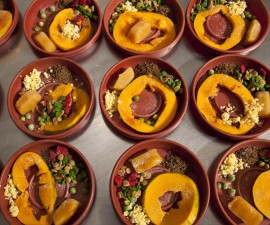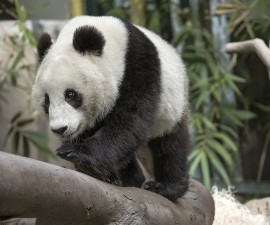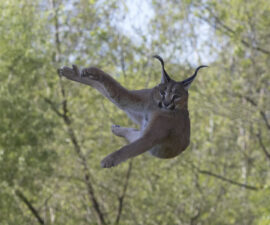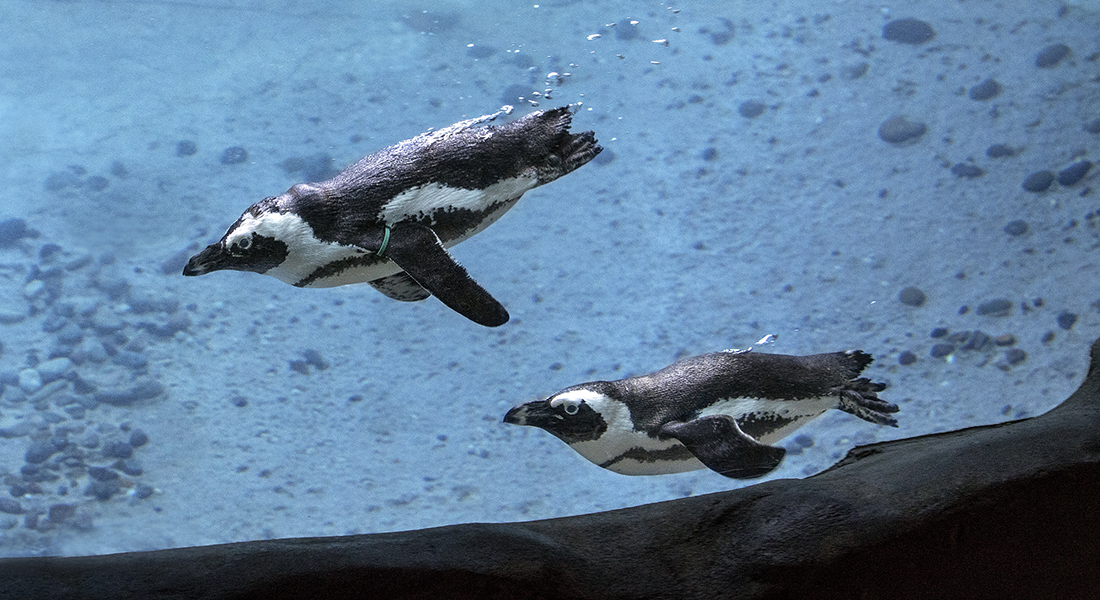
Triple the Fun
The Zoo’s population of African penguins just jumped from two to six—and more are on the way!
BY Eston Ellis
Photography by Ken Bohn
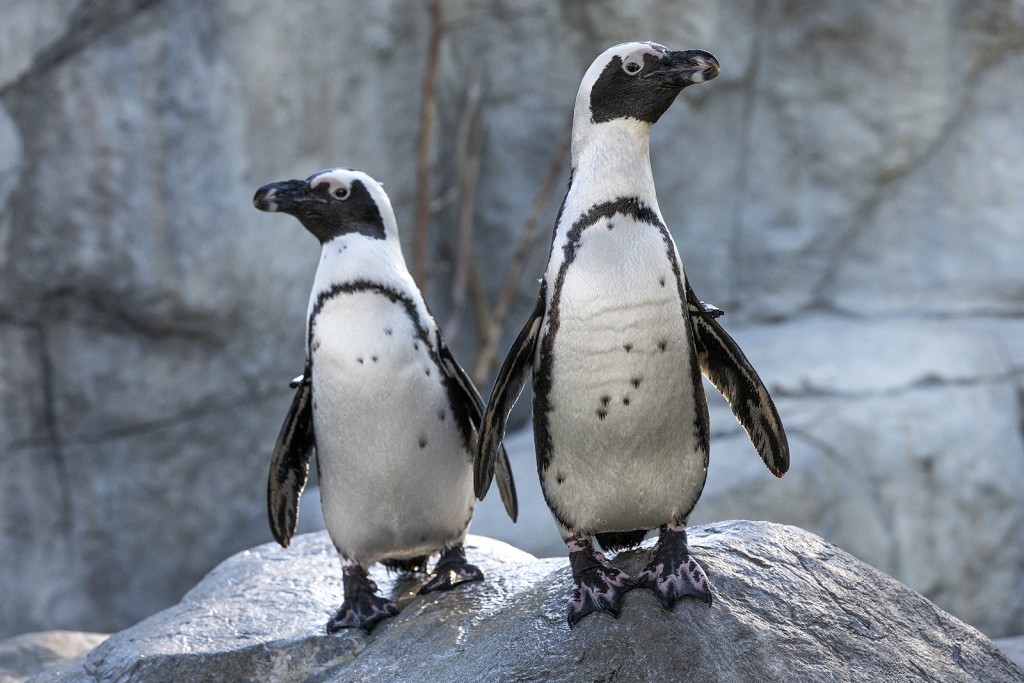
SURF AND TURF
At their current exhibit in the Children’s Zoo, African penguins enjoy zooming underwater (Vi and D.G. are swimming, at top) and soaking up the sun on their pool’s adjacent rocky shoreline (Dan and McKinney stand tall atop the rocks, above).
 Average body weight of a penguin (pounds)
Average body weight of a penguin (pounds)
 Average body length/height of a penguin (feet)
Average body length/height of a penguin (feet)
If you thought two young African penguins Spheniscus demersus brought a new wave of fun to the San Diego Zoo last year, just wait until you see the antics of our current flock of six—four males and two females. The first two—precocious three-year-old brothers Dan and McKinney—arrived in December 2014 from Idaho Falls’ Tautphaus Park Zoo and went on exhibit in April 2015. Two more were added in January 2016: a bonded mating pair in their mid-20s, Vi and D.G., from the Dallas Zoo. This established couple added a new dynamic to the group, along with the possibility of chicks in the future. Another pair—a male and a female that hatched in 2014 at San Francisco’s Steinhart Aquarium, named Mac and Norinne—joined the flock in March 2016.
They currently can be seen frolicking in the former otter pool at the Children’s Zoo, but they will move into expansive new digs next year, when the Conrad Prebys Africa Rocks exhibit opens. This 8-acre, $68 million exhibit will be home to plants, reptiles, mammals, and birds native to Africa—including hamadryas baboons, geladas, vervet monkeys, lemurs, dwarf crocodiles, agama lizards, spurred tortoises, southern ratels (better known as honey badgers), fossa, and leopards. It will also be home to Penguin Beach: the Dan and Vi McKinney Penguin Habitat, which will provide remarkable up-close views of these endangered warm-weather sea birds, both on shore and underwater. The Zoo’s African penguin colony will increase dramatically, eventually including over 20 breeding pairs.
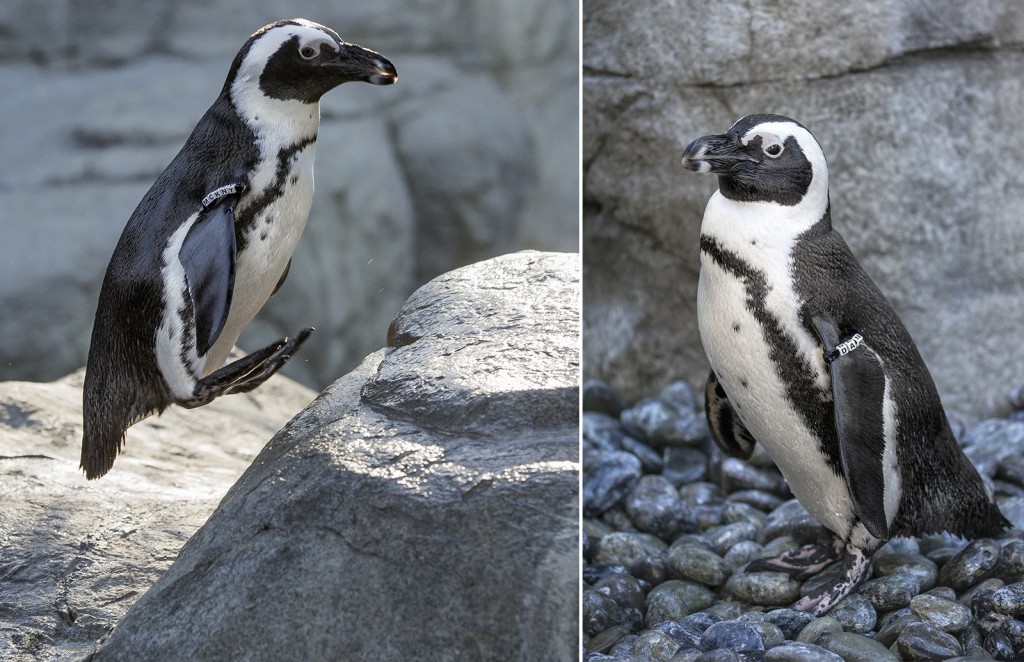
WHO’S WHO?
If their behaviors aren’t enough to clue you in on “who’s who” in our penguin colony, you can check their nametags, which look something like children’s name bracelets. These prototypes were created by Joop Kuhn, Bird Department animal care manager, and are currently being tested to see how long they will last while worn daily.
But the current flock at the Children’s Zoo is already attracting a lot of attention, said Dave Rimlinger, the San Diego Zoo’s curator of birds. “I have never seen any other bird that has generated this type of excitement, among guests and staff alike.” Take one look at the playful African penguins in their current exhibit, and it’s easy to see why they captivate everyone they meet.
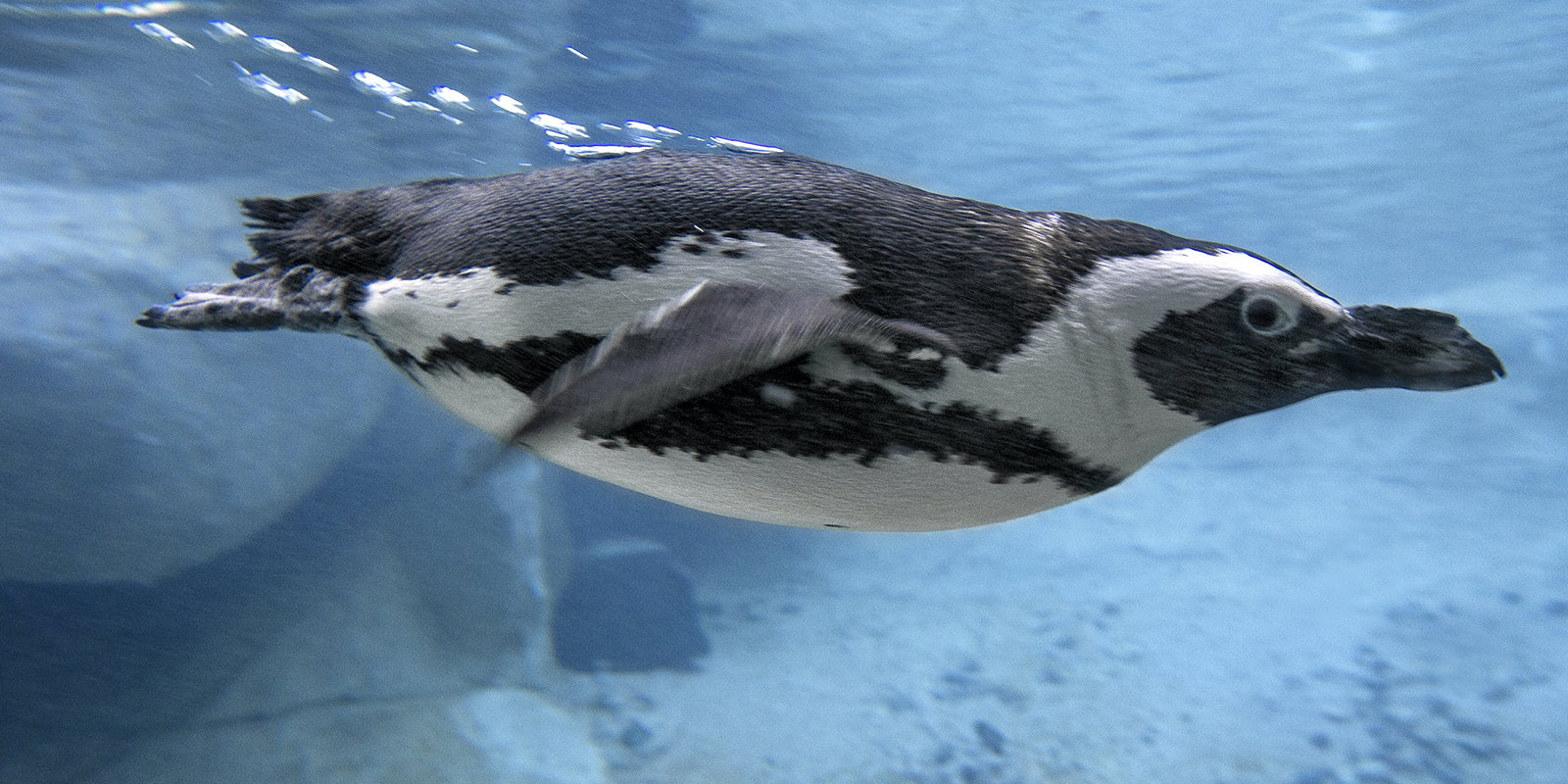
 Eggs laid by a penguin in one clutch
Eggs laid by a penguin in one clutch
 Days of egg incubation period for an African penguin
Days of egg incubation period for an African penguin
MEET THE FLOCK
Energetic and athletic Dan and McKinney spend a lot of time zooming back and forth in their pool, diving deep, and porpoising in and out of the water from one end of the viewing windows to the other—demonstrating how African penguins can reach in-the-water speeds up to 12 miles per hour. They also like to watch Zoo guests react in wonder at their hijinks. Dan and McKinney are trained in husbandry behaviors like taking food and medicine from keepers’ hands, weigh-ins and any necessary health maintenance. They are gregarious animal ambassadors and sometimes make special appearances to educate and inspire groups about their species.
Vi and D.G. are a bit more standoffish, spending most of their time sunning on the rocks or resting on the pool’s rocky shoreline. This monogamous pair has experience hatching chicks and is expected to stay together. At first, the finely feathered couple did not take to hand feeding, but that has changed as they’ve started getting comfortable in the exhibit, explained Kelly Lee, senior keeper. “If the two boys would come up and take food out of my hand, Vi and D.G. would notice: ‘Hey: they trust her.’ So, now it’s okay.
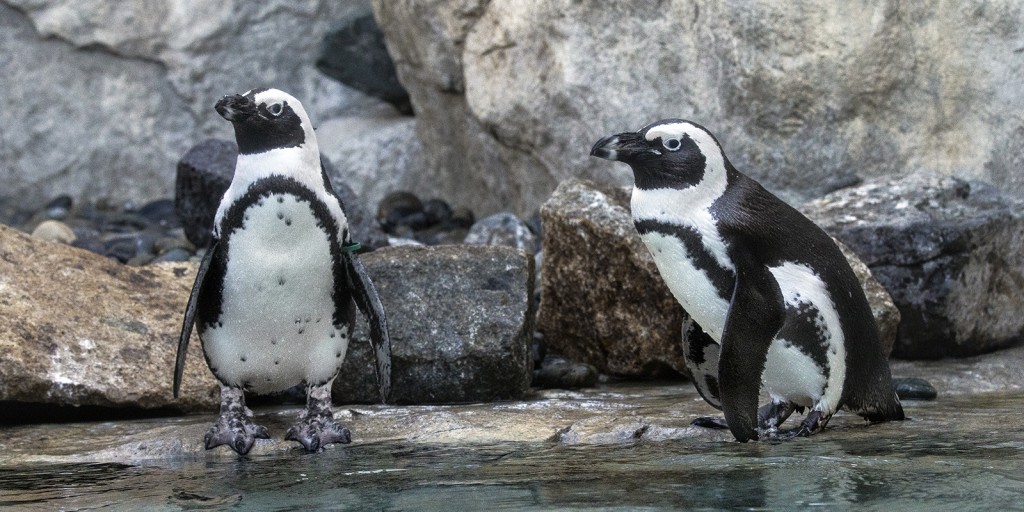
BLACK TIE AND TAILS
While they may look like they are wearing matching tuxedos, each individual African penguin—including Vi and D.G., shown here—has its own distinct pattern of stripes and spots that sets it apart from all others.
They definitely have a flock mentality, and that does work in my favor sometimes.” The boys tend to do their own thing while Vi and D.G. soak up the sun. However, “the whole flock gets along well—and they have since they were first introduced to each other,” said Clint Lusardi, animal care supervisor.
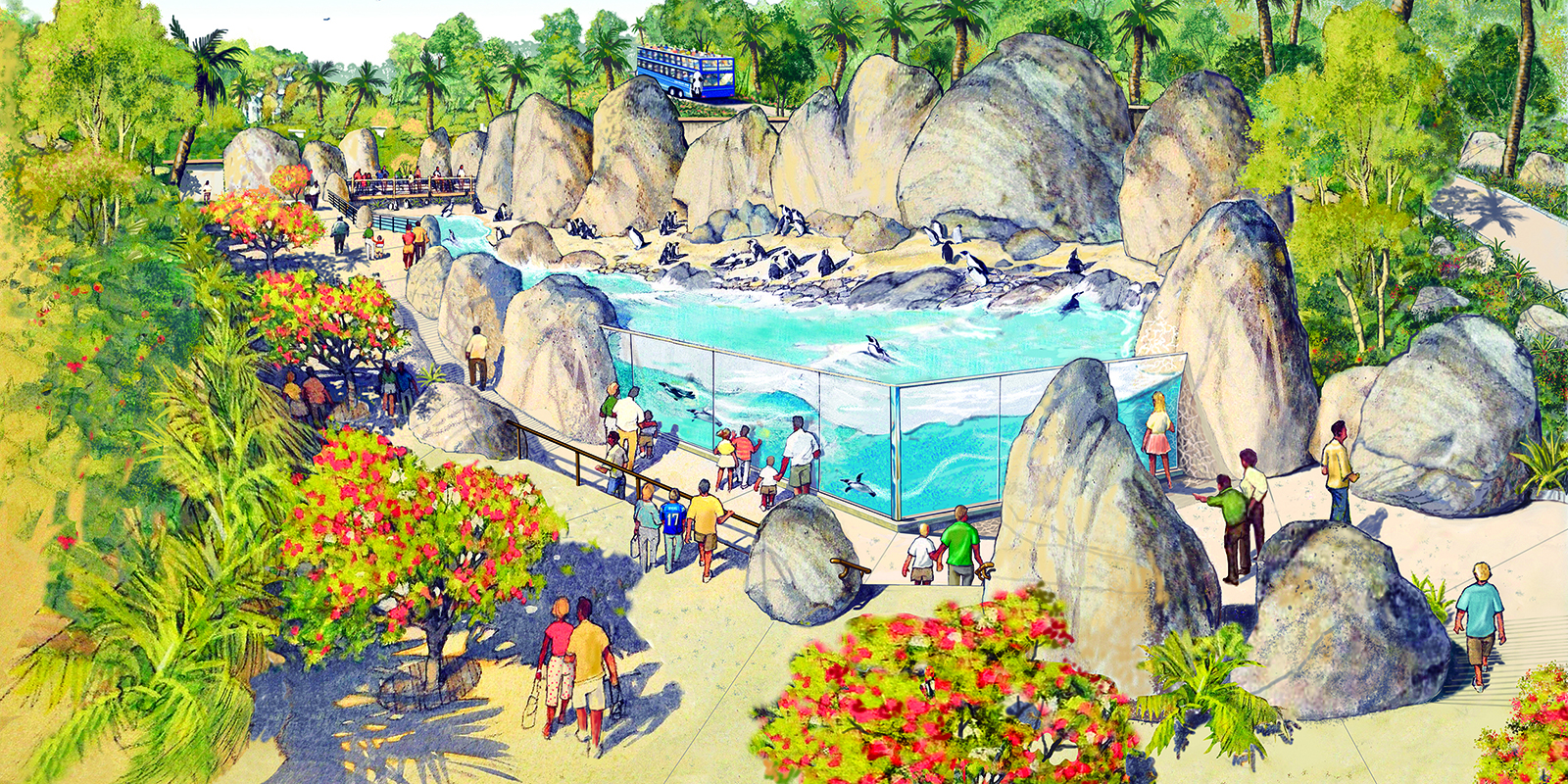
 Months of age at fledging
Months of age at fledging
 Years of age at maturity
Years of age at maturity
ON THE ROCKS
Changes are coming, as Africa Rocks inches closer to completion. “African penguins like to gather in large groups—and we will definitely have a large group at Africa Rocks,” said Joop Kuhn, Bird Department animal care manager. Africa Rocks’ Penguin Beach will offer a similar look and feel to South Africa’s Boulders Beach penguin habitat—with a sandy shoreline studded with giant boulders, and a 100,000-gallon pool with ocean-style waves. Guests will be able to see the penguins gather on the beach, swim in the surf, and dive deep underwater. Floor-to-ceiling glass walls will provide one-of-a-kind underwater viewing at the deep end of the penguins’ new pool—15 feet below the water’s surface—showcasing penguins’ underwater maneuvers, along with fish and other marine life.
Adjacent to all of this will be a 1,890-square-foot penguin care center—with an indoor pool, a veterinary care room with a smaller pool, two penguin food-prep kitchens, and storage. From inside the building, keepers will be able to access 30 underground burrows that lead to nest boxes, allowing staff to monitor and care for nesting penguins and their young.

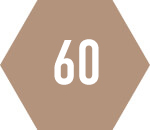 Percentage the population has declined in the last 28 years
Percentage the population has declined in the last 28 years
 Chicks rehabilitated by SANCCOB last year
Chicks rehabilitated by SANCCOB last year
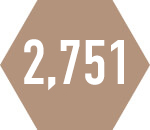 Individuals in assurance population in 2015, in 103 zoos and aquariums worldwide
Individuals in assurance population in 2015, in 103 zoos and aquariums worldwide
ENDEARING AND ENDANGERED
Today, only about 52,000 mature African penguins exist worldwide—on islands and mainland beaches in South Africa and Namibia. Their numbers continue to decrease as a result of several factors: overfishing and climate change, which diminish populations of fish near chick-raising areas; degradation of nesting areas by commercial guano harvesting operations, now mostly prohibited; oil spills; and predation of chicks and eggs by humans, fur seals, and feral domestic animals.
One of the major components of the Zoo’s new African penguin exhibit will be a breeding program, which will help increase an assurance population of the species. African penguins living in zoos worldwide are managed through the Association of Zoos and Aquariums’ Species Survival Plan (SSP), designed to ensure that a strong, healthy, and genetically diverse population continues to exist. The African penguin SSP program has shaped an assurance population that is demographically sustainable for more than 100 years (maintaining 90-percent genetic diversity over time), making it possible to release birds in their natural habitat to restore declining populations. The new breeding pairs at Africa Rocks will help sustain this highly endangered species and build a brighter future for African penguins.
In addition, San Diego Zoo Global has been working with the South African Foundation for the Conservation of Coastal Birds (SANCCOB). This organization maintains two care centers and rescues ailing, injured, abandoned, and oil-soaked penguins and other seabirds. Last November, Joop traveled to South Africa, and spent two weeks working in SANCCOB’s annual Chick Bolstering Project. SANCCOB volunteers rescue chicks and eggs that are injured or abandoned, incubate abandoned eggs, assess the chicks’ health needs, put the young birds on whatever track they require to develop successfully, and then release them, Joop explained.
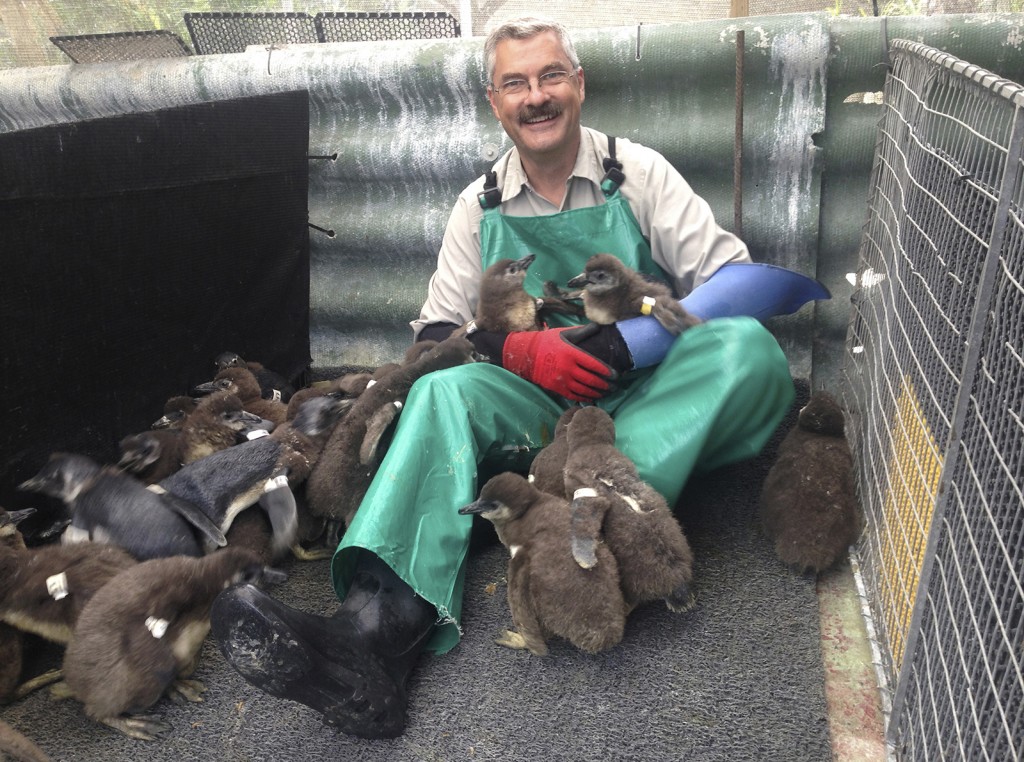
HELPING THE NEXT GENERATION
San Diego Zoo Bird Department animal care manager Joop Kuhn spent two weeks in South Africa in 2015, working with SANCCOB’s Chick Bolstering Project to help care for injured and abandoned young African penguins that will be released back into the wild.
The Zoo’s Veterinary Services and Nutritional Services departments, along with the Institute for Conservation Research’s Wildlife Disease Laboratories, provided supplies for SANCCOB, along with Joop’s assistance in the care and tube-feeding of chicks. “SANCCOB is a well-established organization that has been doing front-line conservation work for many years—taking hundreds of animals that would otherwise not survive, rescuing them, caring for them, and then putting them back into their native habitat,” Joop said. “They do for African penguins what we do for many other species: it’s like us putting California condors back in the wild.”
Like the California condor, the endangered African penguin has many admirers—and in summer 2017, the Zoo’s new Penguin Beach at Africa Rocks will provide a spectacular place where the penguins can thrive. Check out the African penguins at their current exhibit in the Children’s Zoo, and catch the latest adventures of our flock anytime on the Penguin Cam at sandiegozoo.org. There’s never a dull moment in this dynamic “six-pack”!

